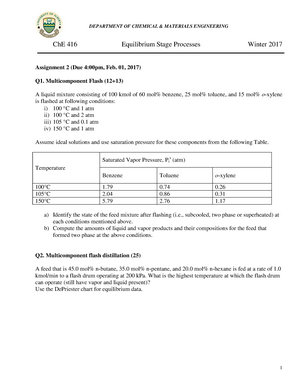
Because the other three methods must be done in American customary units, the Clausius-Clapeyron method also will be converted to those units. It also can be solved by slopes fitting an equation of the form log( p v) = c/ T+ b to the two data points. reciprocal absolute temperature and extrapolating. The Clausius-Clapeyron equation can be solved graphically by plotting a log of vapor pressure vs. Estimate the vapor pressure of hexane at 100☌, using all the methods outlined previously. The vapor pressure of pure hexane as a function of temperature is 54.04 kPa at 50☌ and 188.76 kPa at 90☌. Values of acentric factors can be found in Poling et al., who also presented many other available vapor-pressure correlations and calculation techniques, with comments about their advantages and limitations.Įxample: Estimating vapor pressure of a gas The advent of computers, calculators, and spreadsheets makes the use of approximations and charts much less advantageous than it was before the 1970s. Lee-Kesler is the preferred method of calculation but should be used only for nonpolar liquids. Which can be solved easily by computer or spreadsheet. Lee and Kesler have expressed f 0 and f 1 in analytical forms:

Where p vr is the reduced vapor pressure (vapor pressure/critical pressure), f 0 and f 1 are functions of reduced temperature, and ω is the acentric factor. extended the expansion to contain three parameters: The most common expansions of the Clapeyron equation lead to a two-parameter expression. Vapor pressures also can be calculated by corresponding-states principles. Generally, the Antoine approach can be expected to have less than 2% error and is the preferred approach if the vapor pressure is expected to be less than 1,500 mm Hg (200 kPa) and if the constants are available. Knowledge of the vapor pressure at two temperatures will fix A and B and permit approximations of vapor pressures at other temperatures. This equation generally is known as the Antoine equation because Antoine proposed one of a very similar nature that used 13 K for the constant C. Where A and B are empirical constants and, for compounds boiling between 32 and 212☏, C is a constant with a value of 43 when T is in K and a value of 77.4 when T is in °R. The Cox chart was fit with a three-parameter function by Calingeart and Davis. 2 – Cox chart for normal paraffin hydrocarbons. Its accuracy is dependent to a large degree on the readability of the chart.įig. This approach is very useful and can be much better than the Clapeyron method.

Thus, it is necessary to know only vapor pressure at one temperature to estimate the position of the vapor-pressure line. In addition to forming nearly straight lines, compounds of the same family appear to converge on a single point. A Cox chart, using water as a reference material, is shown in Fig. This is especially true for petroleum hydrocarbons. The vapor-pressure/temperature plot forms a straight line, at least for the reference compound (and usually for most of the materials related to the reference compound). Therefore, the use of the Clausius-Clapeyron equation is not recommended when other methods are available, except over short temperature ranges in regions where the ideal gas law is valid.Ĭox further improved the method of estimating vapor pressure by plotting the logarithm of vapor pressure against an arbitrary temperature scale. However, the shape of this relationship for a real substance over a significant temperature range is more S-shaped than straight. Such a plot is useful in interpolating and extrapolating data over short ranges. This equation suggests that a plot of logarithm of vapor pressure against the reciprocal of the absolute temperature would approximate a straight line. Where b is a constant of integration that depends on the particular fluid and the data range.

Which is known as the Clausius-Clapeyron equation.



 0 kommentar(er)
0 kommentar(er)
